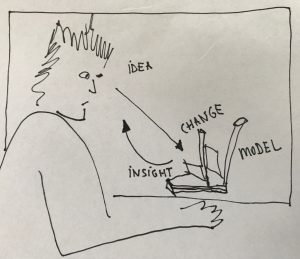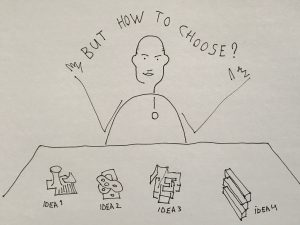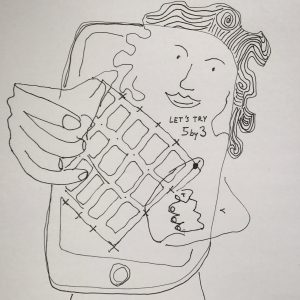2.2.2 Knowledge
Course subject(s)
Module 2 – Your Dream House
Sketch Models
Many sorts of models can be distinguished, but here in this course, we will discuss only three different types of models that have a very different role in the design process. We will start with Sketch Models.
Sketch models are physical figments of our imagination. They require both trust and freedom in order to develop and formulate your ideas, some which may be good and others that may be mistakes. It is only when you do not feel limitations that you can invent new things. Sketches can be like propositions or hypotheses that still need more precision, further testing and proof that these ideas can work.
Sketching with models requires you to adopt the skills of children – they play, they dream, and they see and experience things differently with a certain naivety and newness. Along with drawing, building models is another method for architects to develop and share their ideas and this is often a playful communication process with themselves and with others. It is a dialogue not just about facts, but should be open for play and interpretation.
Architects often look for a certain analogy between the properties of the scale model, the digital model, the real world and the figments of their imagination. Within the sketching process, one can see at least three sub-methods:
- Developing one model by incrementally making adaptations,
- Developing several options at the same time, and
- Fine tuning each aspect in parametric ways.

1. A sketch model can be made incrementally (step by step). This involves the initial ideas of the architect being roughly sketched into the model. Then, by observing the model from different angles, the model can give back new insights for the architect, who can then adapt the model and try out the next step in the design development. Here it is very important for the architect to stay in control. The ideas need to be critically evaluated and important insights need to be noted down. Taking pictures while working on a sketch model is a good way to capture the process and to later reflect on ‘what the heck’ you were doing. Later on, it can also be good to trace or draw over the printed images of the photographed model in order to investigate what properties in the model are most relevant for the design.

2. This image shows another way of sketching and developing your ideas. Here the different ideas or the different versions of one idea are developed in parallel, but the architect is not yet sure which to choose. Often there are too many good ideas, so these ideas are temporarily investigated in parallel. It is a bit like evolutionary development. The ideas are developed into models regardless of how good they look beforehand. Only by testing them can you decide which can survive. Like in evolution, some cross-breeding can help to improve the design. Ideas can be reused and combined, mistakes can be rendered out. In our design courses at the Faculty of Architecture we tell the students that they are allowed to steal ideas from one other in the early stages of design. So we sometimes have a classroom full of little sketch models, 10 per student, 300 from the whole group. Then we look at the models and start interpreting each others ideas. This is a peer-to-peer process that brings a large benefit for each individual designer. In this MOOC we will do something similar. With so many participants from all over the world it would be great to share ideas by showing sketches on your Weebly portfolios, but we will explain more about this later.

3. A third kind of sketching with models relates to something that is happening all the time. When you move an object, you immediately get visual feedback about how it is placed in relation to other objects. When you, for example, crop a picture on the screen of a mobile phone, or when you add a table in a Word document, you decide on the size, format etc. In the process of digital drawing and modelling you constantly make sketches that are immediately tested and adapted. With digital sketching it is often easier to make a copy and develop the copy into another sketch variant. Digital sketches can also be developed in more complex ways by means of parametrically computed models, while physical sketch models develop with the natural properties of the materials that they are made from.
EXAMPLE 1
Here you see a series of sketch models for a summer house on a small island in the Venetian Lagoon called Isola Madonna del Monte. The island already houses one old structure, since there is a large ruin dating from the 13th century. The house must offer space for six to ten people and should include a large kitchen, two bathrooms, three to four bedrooms, a living area and at least one terrace. Here you can see experiments with different concepts related to the shape of the island, the ruin and the main shape of the summerhouse.

EXAMPLE 2
In this example, many sketch models were built not for the larger design concept, but for a more detailed study of the possible ways of forming the roof, and in the second row, with the aim of designing a clear route towards the building.

EXAMPLE 3
Sketching not only takes place in physical models. Here you see an example of a 3D-print in which a very complicated form can be created. In so called ‘Parametric Computer Aided Design (CAD)’ software, the form can be changed. The second image is an example of the method of the parametric program that determines how the digital model is transformed. The parameters can be all kinds of values that the architect can change. For example, the thickness of the geometry and the size of the holes.


Serious Playfulness
Frank Gehry is the ‘starchitect’ of many iconic buildings, all over the world. Please, take a look at the video below, from the DVD Sketches of Frank Gehry, by Sydney Pollack.

Models in Architecture by TU Delft OpenCourseWare is licensed under a Creative Commons Attribution-NonCommercial-ShareAlike 4.0 International License.
Based on a work at https://ocw.tudelft.nl/courses/models-architecture-design-physical-digital-models/.



